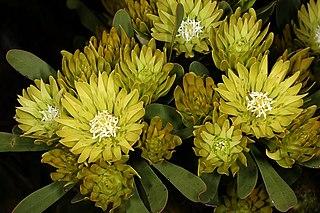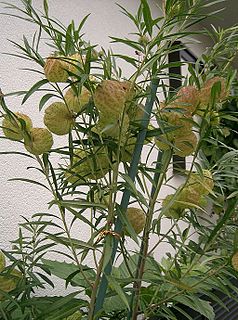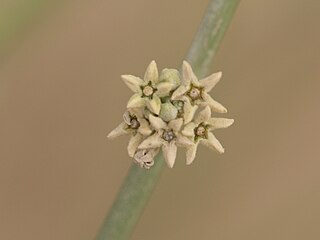
Leonotis is a genus of flowering plants in the family Lamiaceae. One species, Leonotis nepetifolia, is native to tropical Africa and southern India. It is naturalized throughout most of the tropics. The other species are endemic to southern + eastern Africa.

The genus Huernia consists of perennial, stem succulents from Eastern and Southern Africa and Arabia, first described as a genus in 1810.

Protea neriifolia, also known as the narrow-leaf sugarbush, oleander-leaved sugarbush, blue sugarbush, or the oleanderleaf protea, is a flowering plant in the genus Protea, which is endemic to South Africa.

Aulax is a South African Proteaceae genus of just three species of evergreen shrubs commonly known as "featherbushes". It is unusual among the many South African Proteaceae in having male and female flowers on separate plants. The bushes have fine needle-like foliage. In spring and summer female plants produce funnel-shaped Leucospermum-like flowerheads that develop into seed cones. The catkin-like male flowers are yellow.

Gomphocarpus is a genus of plants in the family Apocynaceae first described as a genus in 1810. It is widespread across much of Africa, with a few species naturalized in other regions.

Piaranthus is a succulent plant genus in the subfamily Asclepiadoideae, in the family Apocynaceae.
Eustegia is a genus of vines in the family Apocynaceae, first described as a genus with this name in 1810. It is native to southern Africa.
- Eustegia filiformis(L.f.) Schult.
- Eustegia fraternaN.E.Br.
- Eustegia hastata(Thunb.) R. Br. ex Schult.
- Eustegia macropetalaSchltr.
- Eustegia minuta(L.f.) N.E.Br.
- Eustegia plicataSchinz

Leptadenia is a genus of plants in the family Apocynaceae, first described as a genus in 1810. It is native to Africa, including Madagascar, as well as southwest Asia and the Indian Subcontinent.
- Leptadenia arborea(Forssk.) Schweinf. - Sudan, Ethiopia
- Leptadenia lancifolia(Schumach. & Thonn.) Decne. - tropical Africa
- Leptadenia madagascariensisDecne. - Madagascar
- Leptadenia pyrotechnica(Forssk.) Decne. - widespread from Algeria to India
- Leptadenia reticulata(Retz.) Wight & Arn. - Madagascar
Hemipogon is a genus of flowering plants in the family Apocynaceae, first described as a genus in 1844. It is native to South America.

Leucospermum oleifolium is an erect shrub of about 1 m (3.3 ft) high and 1½ m (5 ft) across that is assigned to the family Proteaceae. It has spreading branches, densely set with initially felty, entire, oval, olive-colored leaves of about 3½ cm long and 1½ cm (0.6 in) wide, with a bony tip that sometimes has two to five blunt teeth, with a blunt base and conspicuous veins. The flowers and their long thread-like styles are initially sulfur yellow, but soon become orange and finally turn brilliant crimson. The flower heads are about 4 cm (1.6 in) in diameter, crowded at the tip of the branches with a maximum of five that start flowering in turn. This provides for a colour spectacle from August till December. It is called by various names in South Africa such as Overberg pincushion, flame pincushion, mix pincushion and tuft pincushion. It naturally occurs in fynbos in the Western Cape province of South Africa.

Protea pendula, also known as the nodding sugarbush or arid sugarbush, is a flowering plant of the genus Protea, in the family Proteaceae, which is only found growing in the wild in the Cape Region of South Africa. In the Afrikaans language it is known as knikkopsuikerbossie or ondersteboknopprotea.

Protea angustata, also known as the Kleinmond sugarbush, is a flowering shrub that belongs to the genus Protea. This plant is endemic to the south-west Cape Region of South Africa.

Protea nana, also known as the mountain rose or mountain-rose sugarbush, is a flowering shrub which belongs within the genus Protea.
Protea lorea, also known as the thong-leaf sugarbush, is a flowering shrub belonging to the genus Protea.

Protea canaliculata, also known as the groove-leaf sugarbush, is a species of flowering shrub of the genus Protea, which is endemic to the Cape Provinces of South Africa.
Protea scabra, also known as the sandpaper-leaf sugarbush, is a flowering groundcover that belongs to the genus Protea. The plant is endemic to South Africa and is found from the Hottentots Holland Mountains across the Riviersonderend Mountains, the Kleinrivier Mountains and around the town of Caledon to the Swartberg mountains.
Protea laevis, also known as the smooth-leaf sugarbush, is a flowering shrub that belongs within the genus Protea.
Protea revoluta, also known as the roll-leaved sugarbush or rolled-leaf sugarbush, is a species of plant which is classified in the genus Protea. P. revoluta is only found growing in the wild in South Africa, where plants can be found growing between the Cederberg inland on the Atlantic coast and the Witteberg area to the north.

Protea caespitosa, also known as hottentot bishop sugarbush or bishop sugarbush, is a flowering shrub belonging to the genus Protea which is only found growing in the wild in South Africa.













